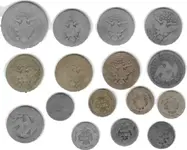Re: How 'worn' was silver pocket change?
I started collecting coins in 1964 when I was in 4th grade. My grandfather was a barber and he let me go through his change and reimburse him for anything I took out. I also had a great uncle who was President of our bank who got my first silver dollars for me when somebody deposited them (2 Peace dollars that cost me a buck apiece!). Back then I was only interested in anything older than 1940 as well as any steel cents, War Nickels, Mercury dimes, Walking Liberty halves and silver dollars. It was not uncommon to find Lincoln cents dating back to the teens (1919 being somewhat common).
I remember most of the Standing Liberty quarters still in circulation then were worn fairly smooth and had no dates, the youngest of them being 34 years old at the time. Most of the older Walkers had no or barely legible dates; the later Walkers were only 17 years old at the time. Most Buffalo Nickels had no dates.
People back then did not collect coins like today and they rarely even looked at their change so coins circulated a long time. You asked, "Is the clad of today that much more durable?". The simple answer is "yes". Today?s clad coins have surfaces of cupro-nickel (75% copper & 25% nickel) which is the identical composition of nickels. Silver is a much softer metal than nickel so it stands to reason today's clad coinage does not wear nearly as quickly as 90% silver coins. That's why a 40 year old 1965 Washington quarter found in circulation doesn't have nearly as much wear as a Standing Lib quarter found in circulation in 1965.
You might wonder why so many V nickels and Buffalo nickels have so much wear compared to nickels of today. The simple answer to that is 5? bought a lot back then. A Coke was 5?. Nickelodeons cost (surprise!) 5?. Pay phones cost 5?. The nickel was the workhorse back then and they saw a LOT of use, much like the quarter of today (even though a quarter today buys less than a nickel back then).
Below are some well-worn silver coins.





